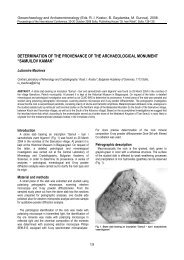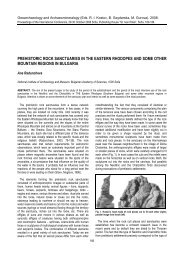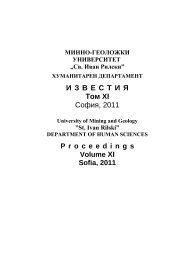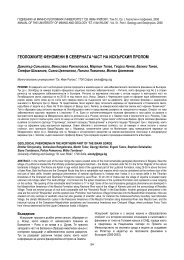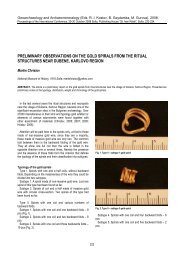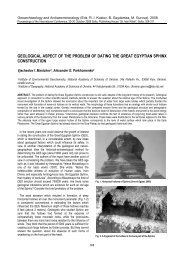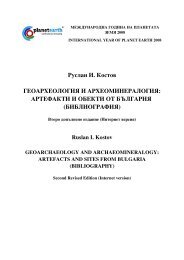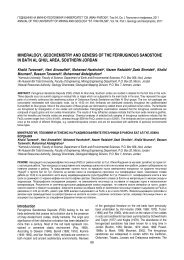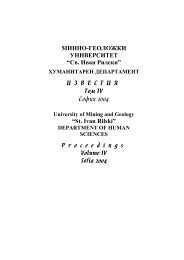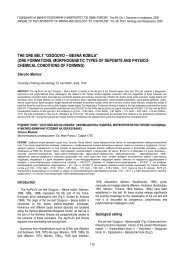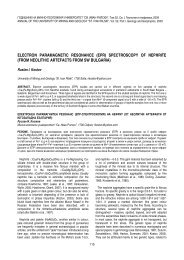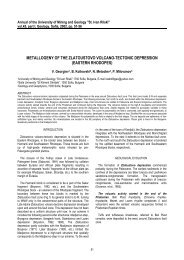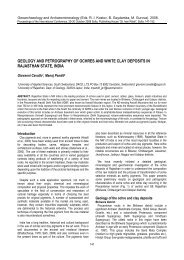FORMAL EARLY NEOLITHIC FLINT TOOLKITS ...
FORMAL EARLY NEOLITHIC FLINT TOOLKITS ...
FORMAL EARLY NEOLITHIC FLINT TOOLKITS ...
You also want an ePaper? Increase the reach of your titles
YUMPU automatically turns print PDFs into web optimized ePapers that Google loves.
Fig. 4. Cryptocrystalline chalcedony, microfauna filled with microcrystalline<br />
chalcedony and clastic particles – blade fragment, Neolithic<br />
archaeological site Yabalkovo, sample N18; possible source – Upper<br />
Cretaceous (Moesian flint); transmitted light, crossed polars<br />
Further thin section analyses should reduce the potential<br />
candidates for original outcrops of the toolkits under<br />
discussion. Although archaeological evidence for Neolithic<br />
workshops in the region of North-East Bulgaria is absent, we<br />
have to presume that they existed in the Early Neolithic for<br />
ensuring suitable nodules, cores (about 18-20 cm long) and<br />
debitage (blades): all these products were predestined for long<br />
distance exchange of good and perhaps embodied know-how.<br />
Sedimentological aspects of prehistoric flints<br />
The siliceous concretions (flint) are relatively well studied in<br />
Bulgaria. The published sedimentological works are about<br />
Upper Jurassic siliceous concretions in West Bulgaria<br />
(Atanasov, 1954; Nachev, 2005), Low Cretaceous flint in<br />
Northeast Bulgaria (Goranov, 1965; Nachev, Kanchev, 1984;<br />
Nachev, 2008, in press) and Upper Cretaceous siliceous<br />
concretions (Soultanov, 1982; Nachev, 2008 in press).<br />
32<br />
Part of the present work is based on sedimentological<br />
examinations of flint and flint-like materials from the territory of<br />
Bulgaria. They include terrain observation (more than 100<br />
localities), macroscopic observations (descriptions of<br />
specimens – 480 numbers) and microscopic descriptions (700<br />
thin-sections from 65 outcrops). The microscopic observations<br />
of artefacts with Neolithic and Chalcolithic age have<br />
preliminary character and are based on macro-and<br />
microscopic observations of 180 thin sections from 16<br />
archeological sites. According to some authors, the siliceous<br />
concretions (flint) consist from autogenic minerals of SiO2<br />
(silica). They have concretion structure and are hosted<br />
predominantly in limestones or chalk. The natural flint outcrops<br />
are widely spread in Bulgaria. The siliceous concretions are<br />
represented in almost geographic and morphotectonic zones.<br />
Significant accumulations are located in the Moesian<br />
Platform and adjustment parts of the Balkan Alpine Orogen<br />
(Fig. 5) (Nachev, Nachev, 1986). In the Phanerozoic rocks in<br />
Bulgaria the siliceous concretions are found in 16 stratigraphic<br />
levels and different paleogeodynamic environments are<br />
recognized (Nachev, Nachev, 1989). The main stratigraphic<br />
levels, which are of theoretical and practical interest for<br />
archeology, are the Upper Jurassic (Oxfordian), the Low<br />
Cretaceous (Aptian) and the Upper Cretaceous (Coniacian,<br />
Campanian and Maastrichtian).Some meaning in archaeology<br />
may have the hydrothermal chalcedony veins in the Upper<br />
Cretaceous Sredna Gora zone (Sredna Gora atypical flint) and<br />
in the Oligocene Rhodopes volcanic zone (Rhodopes atypical<br />
flint). The term “Pre-Balkan Platform” is not a correct term for<br />
Moesian Platform. The “Balkan flint” probably means every flint<br />
in the Moesian Platform and adjustment parts of the Balkan<br />
Alpine Orogen including both Low Cretaceous (Aptian) flint and<br />
Upper Cretaceous (Campanian and Maastrichtian) flint. The<br />
geographic and stratigraphic distribution of the main levels of<br />
siliceous concretions (flint) with archaelogocal significance in<br />
Bulgaria is shown on Fig. 5.<br />
Fig. 5. Geological map of the main types of flint-born rocks in Bulgaria: 1 – Upper Jurassic limestones (Oxfordian age) with siliceous concretions (J3 ox ) -<br />
Hemus flint; 2 – Low Cretaceous (Aptian age) limestones with siliceous concretions (К1 a ) – Luda Gora flint (Dobrudzha flint); 3 – Upper Cretaceous chalk<br />
and chalk-like limestones (Campanian and Maastrictian ages) with siliceous concretions (К2 cp-m ) – Moesia flint; 4 – Upper Cretaceous volcanogenous<br />
rocks (Coniacian, Santonian and Campanian ages) in Sredna Gora Zone (K2 Cn-Cp ) – Sredna Gora atypical flint; 5 – Chalcedony veins in Oligocene<br />
volcanogenous rocks in Rhodope Zone (Pg3) – Rhodope atypical flint ; 6 – boundary between tectonic zones



